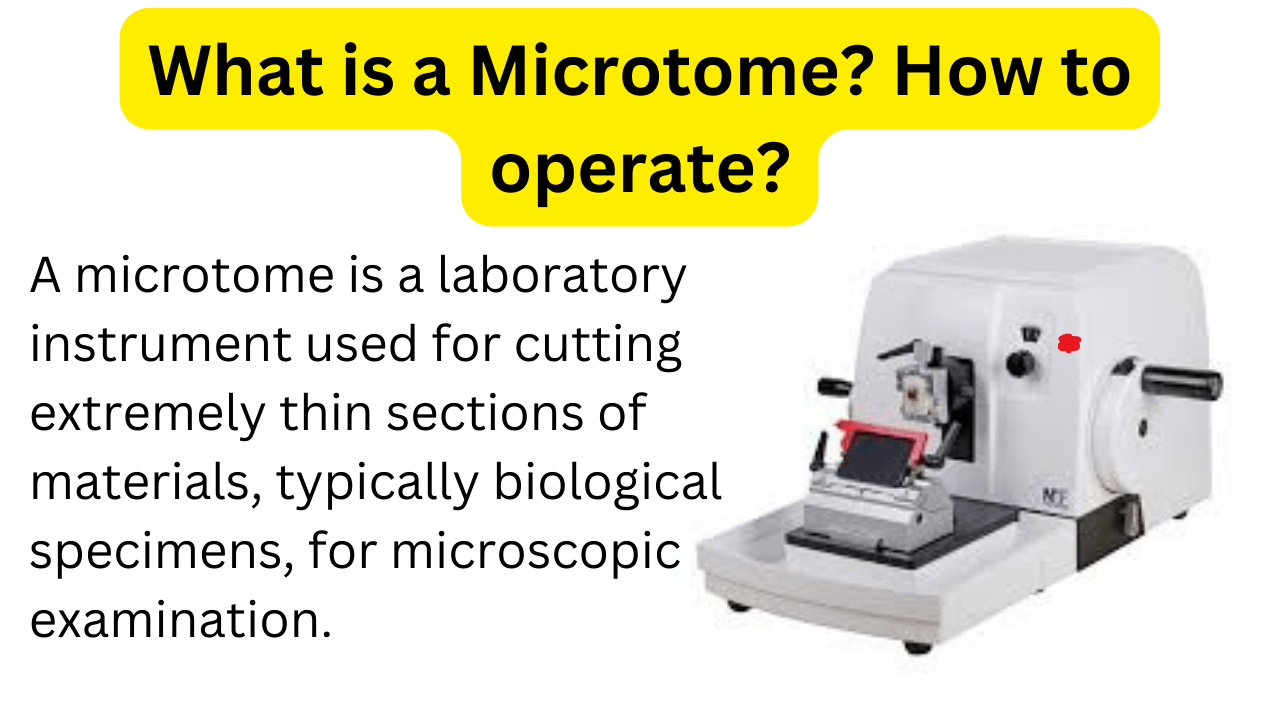A microtome is a laboratory instrument used for cutting extremely thin sections of materials, typically biological specimens, for microscopic examination.
It is an essential tool in various scientific fields, including biology, and histopathology.
These instruments are essential for studying the intricate structures of tissues, cells, and various specimens, contributing significantly to our understanding of various diseases.
Principle of microtome
Precision cutting of specimens into consistently thin slices for microscopic examination, using a sharp blade and a mechanism to control the thickness of the sections.
Types of Microtomes
There are FOUR main types of microtome.
- Rotary microtome
- Cryostat microtome
- Vibrating microtome
- Ultramicrotome
Rotary Microtome
- Rotary microtomes are among the most common types. They work on the principle of a specimen being securely mounted on a block that can be rotated as a sharp knife blade slices thin sections from the material.
- These microtomes offer precision and control, allowing for adjustments in section thickness. Researchers can typically cut sections ranging from a few micrometers down to sub-micrometer levels.
Cryostat Microtome
- Cryostat microtome is designed for sectioning frozen specimens. They maintain the sample at extremely low temperatures, making them suitable for materials that may be damaged by traditional paraffin embedding or for preserving specific biological structures.
- It is especially useful for neurological and neuroanatomical studies.
Vibrating Microtome
- Vibrating microtomes employ high-frequency vibrations to cut thin sections. They are particularly valuable for soft and delicate specimens, such as brain tissues.
- These microtomes minimize compression and deformation of the sample, ensuring the highest quality sections.
Ultramicrotome
- Ultramicrotomes are specialized instruments used for cutting ultrathin sections, typically in the range of 50 to 100 nanometers. These sections are prepared for transmission electron microscopy (TEM).
- Ultramicrotomes often use a diamond or glass knife to achieve such precision, making them crucial in nanoscale research.
How to use Microtome in histopathology
Operating a microtome requires precision and attention to detail to obtain high-quality sections. Here are the five steps
- Sample Preparation: Start by embedding your specimen in a suitable embedding medium, such as paraffin or resin. This step helps to stabilize and support the sample during sectioning. Read tissue processing
- Set the microtome to the desired section thickness. Rotary microtomes usually have a microtome advance and sectioning thickness adjustment mechanism.
- Begin sectioning by turning the handwheel or advancing the microtome mechanism. The knife blade will cut thin sections from the specimen as it moves forward.
- Collect the sections as they are cut, typically using a water bath or a section transfer system.
- Stain the sections using appropriate dyes or stains to enhance contrast and visibility under the microscope.
- Cover the stained sections with a coverslip and a mounting medium, securing them in place for microscopic examination.
Rotary microtome uses
- Prepare thin sections of biological tissues for microscopic examination.
- Cut tissue samples from biopsies or surgical specimens for disease diagnosis.
- Create thin sections of materials for detailed analysis of internal structure.
- Facilitate the examination of plant tissues at a microscopic level.
- Aid in the study of material properties by producing thin sections for analysis.
- Used to examine the quality and characteristics of materials in various industries.
- In educational settings, microtomes are employed to teach students about tissue structure and microscopy techniques.
- Assist in the examination of drug effects on tissues and organs.
- Used for precise sectioning of brain tissues in studies related to neuroscience.
- Applied in veterinary medicine for the examination of animal tissues for diagnostic purposes.

I like this web knowledge
Thank you sir
Very interested write up
Thank you for your feedback.